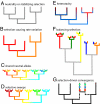Natural selection and phylogenetic analysis
- PMID: 19470454
- PMCID: PMC2690041
- DOI: 10.1073/pnas.0904103106
Natural selection and phylogenetic analysis
Conflict of interest statement
The author declares no conflict of interest.
Figures

Comment on
-
Evidence for an ancient adaptive episode of convergent molecular evolution.Proc Natl Acad Sci U S A. 2009 Jun 2;106(22):8986-91. doi: 10.1073/pnas.0900233106. Epub 2009 Apr 28. Proc Natl Acad Sci U S A. 2009. PMID: 19416880 Free PMC article.
References
-
- O'Hara RJ. Homage to Clio, or, toward an historical philosophy for evolutionary biology. Syst Zool. 1988;37:142–155.
-
- Felsenstein J. Inferring Phylogenies. Sunderland, MA: Sinauer; 2003.
-
- Wake DB. Homoplasy - the result of natural selection, or evidence of design limitations? Am Nat. 1991;138:543–567.
-
- Stewart CB, Schilling JW, Wilson AC. Adaptive evolution in the stomach lysozymes of foregut fermenters. Nature. 1987;330:401–404. - PubMed
Publication types
MeSH terms
Substances
LinkOut - more resources
Full Text Sources

